Georgina Gratrix
By María Minera
While it is fair to say that all painters build their images, this is literally the case for Georgina Gratrix: she builds her works the way, for example, a bricklayer would do, layering cement and bricks on top of each other until a wall or a house has been created. The construction material used here is pigment, so what we see are indeed paintings, insofar as they are hung on a wall, but really, they are small buildings made of color, thick mounds with which Gratrix, in her very peculiar way, creates the appearance of people, animals, and things. This might seem to be an overstatement, but to call
her works “reliefs” is to take away the substance and heft of her absolutely unique way of painting, which involves piling up oil paints to create almost sculptural protrusions. Gratrix’s faces, flowers, and objects occupy space in a way that can only be compared to what one can achieve by working with clay—or, perhaps closer in spirit, with colored play dough.
To look at Gratrix’s paintings from the side is to see that her approach is all about rugged topography. Her canvases are territories that have clearly been conquered by volumes: here a mountain-nose, there a volcano-eye; over here a ridge-ear, back there a row of peak-teeth. This marvelous oil topographer treats the details of the body and its surroundings as if they were elevations on a contour map of the most towering geography—an emotional geodesy, one might say. And it is clear that the result literally stands out at us—or stabs at us, as the case may be. More than appeal to the retina, her paintings cry out to be touched. This is one of their most outstanding qualities: they give us the urge to touch them, or even to taste them, as if their nervous substance were really the delicious merengue of a dessert gone mad.
Unlike the fastidiously polished surfaces of much contemporary painting, Gratrix takes great pains to turn her works, which take her whole weeks to complete, into a visual contradiction: they attract us as much as they challenge us. Those decidedly distorted, carnivalesque, James-Ensor like faces have multiple strata not only of color, but also of meaning, as if each of those faces were
many (as indeed every person’s face is, since we are not one but many): a caricature, then on top of it a decomposed countenance, and on top of that an immense guffaw, then a cubist mask, followed by a set of lively eyes—four of them, in fact—with lashes fanning the air, and above that, at the top of the mountain, a physiognomy that might remind us of someone. And all this is immersed in an “impasto” that threatens to consume the world. The reputedly joyful colors of Gratrix’s paintings would seem to be just a façade, behind which lies life in all its complexity.
Clearly, though, these are festive, hilarious paintings. Here one of course has to laugh, to celebrate each layer of pigment as a triumph over emptiness and inaction, a victory of everything over nothing, a making oneself truly present. These paintings are undoubtedly heavy, but at the same time they seem to enjoy a certain weightlessness: they are so fluid that they vibrate, ripple, and might even shapeshift if one is not paying attention. They have a vitality that contradicts their forcefulness, or better yet loosens it up and reanimates it.
The paintings that Gratrix is showing at Proyectos Monclova were all made in Mexico City, where the artist has spent the past few months working intensely in her studio and visiting such places as the Mercado de Jamaica, the city’s famous flower market, where the curious custom of making animal figures entirely out of flowers has become a fixture; a bit like Jeff Koons’s balloon dogs, but even kitschier, if that’s possible. So here we will see many dogs, many flowers, and—
fantastically—some of the artist’s self-portraits as a parakeet, a volcano, and a Botero-style poodle; as well as chilaquiles, tuna tostadas, green plantains, a Mexican hairless dog, and other charming things she encountered during her long stay in Mexico City, where, by the twists of fate, she happened to have been born in 1982.
For Gratrix, what makes contemporary painting “especially interesting,” as she said in an interview, “is a revisionist and humorous focus that can dig into and have fun with historical representations.” After seeing this exhibition, the visitor will know perfectly well what the artist was talking about.
Georgina Gratrix
Por María Minera
Se podría decir que todos los pintores construyen sus imágenes, pero en el caso de Georgina Gratrix esto es literal: ella construye sus obras como lo haría, digamos, un albañil, poniendo capas de cemento y ladrillos, una encima de la otra hasta completar una pared, una casa. Aquí, es el pigmento el que es utilizado como material de construcción, de modo que lo que vemos, sí, son cuadros, porque están puestos sobre la pared, pero en realidad son pequeñas edificaciones de color; espesos montículos con los que Gratrix compone, a su manera peculiarísima, la apariencia de las personas, los animales y las cosas. Puede parecer una exageración, pero decir que lo que ella hace son relieves es restarle sustancia y peso a ese modo absolutamente suyo de pintar apelmazando los óleos hasta conseguir abultamientos de tipo casi escultórico. Los rostros, las flores, los objetos de Gratrix ocupan el espacio de una manera sólo comparable a lo que puede lograrse en el trabajo con barro o, quizá más cercano en espíritu, con plastilina de colores.
Al observar los cuadros de Gratrix de perfil, nos damos cuenta de que lo suyo es la orografía, pues las telas son territorios que claramente han sido conquistados por volúmenes: aquí, una nariz-montaña; allá, una ojo-volcán; por acá, una oreja-cima; al fondo, una cordillera-dientes. Esta maravillosa topógrafa del óleo trabaja los detalles del cuerpo y del entorno como si fueran elevaciones de terreno en un mapa con una geografía de lo más accidentada –una geodesia emocional, podría decirse. Y es evidente que el resultado, literalmente, salta a la vista –o nos asalta, si se prefiere. Las suyas son pinturas que más que apelar a la retina, convocan al tacto, lo llaman a gritos. Esa es una de sus cualidades más destacadas: que dan ganas de tocarlas; o de probarlas, incluso, como si su nerviosa sustancia fuera en realidad el delicioso merengue de un pastel enloquecido.
A diferencia de las superficies pulidas y cuidadas de mucha pintura contemporánea, Gratrix se esmera en convertir sus obras –a las que dedica semanas enteras– en una contradicción plástica: pues nos atraen tanto como nos desafían. Esos rostros decididamente distorsionados, carnavalescos a la James Ensor, no sólo tienen múltiples estratos de color, sino de sentido, como si cada una de esas caras fueran muchas –como de hecho, es la de todos nosotros, que no somos uno, sino tantos–: una caricatura y encima de ella un semblante descompuesto y sobre éste una inmensa carcajada y luego una máscara cubista y después de la máscara unos ojitos pizpiretos –
cuatro, de hecho– con pestañas que abanican el aire y más arriba, en la punta de la montaña, una fisonomía que tal vez hasta nos recuerda a alguien. Y todo esto inmerso en un “impasto” que amenaza con comerse al mundo. Los colores pretendidamente alegres de las pinturas de Gratrix parecerían ser sólo una fachada, pues más allá está la vida en toda su complejidad.
Pero claro que son pinturas festivas, hilarantes. Aquí hay que reírse, desde luego. Celebrar que cada capa de pigmento es un triunfo sobre el vacío y la inacción. Una victoria del todo sobre la nada. Un hacerse de veras presente. Estas pinturas pesan, no cabe duda, y al mismo tiempo parecen gozar de cierta ingravidez: tal es su soltura, que vibran, se agitan y hasta podrían cambiar
de forma, si uno se descuida. Hay una vitalidad en ellas que contradice su contundencia o que, mejor aún, la desentumece, la reanima.
Los cuadros que Gratrix presenta ahora en Proyectos Monclova están todos hechos en México, donde la artista ha pasado los últimos meses, trabajando intensamente en el estudio y visitando, entre otros lugares, el mercado de Jamaica, donde se ha instalado la curiosa costumbre de crear figuras de animales, pero con puras flores. Un poco como los perritos de Jeff Koons, pero
todavía más kitsch, si cabe. Así que aquí veremos muchos perros, muchas flores y, algo fantástico, unos autorretratos de la artista convertida en perico, en volcán y en poodle de Botero; además de chilaquiles, tostadas de atún, plátanos verdes, un xoloitzcuintle y otros encantos que descubrió en su larga estancia en la Ciudad de México, en la cual, por azares de la vida, vino a nacer en 1982.
Para Gratrix, lo que hace que la pintura contemporánea “sea especialmente interesante”, dijo en una entrevista, “es un enfoque revisionista y humorístico que puede escarbar y divertirse con las representaciones históricas”. Después de ver esta exposición, el visitante sabrá perfectamente de qué estaba hablando la artista.

1
Flores de Malinalco con un xolo, 2023
Óleo sobre tela
190 x 150 x 7 cm
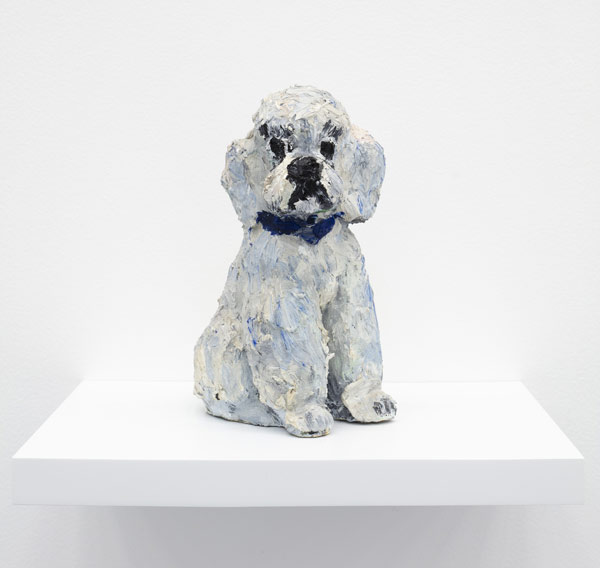
2
White dog, 2023
Cerámica y óleo
23.5 x 11 x 18.5 cm
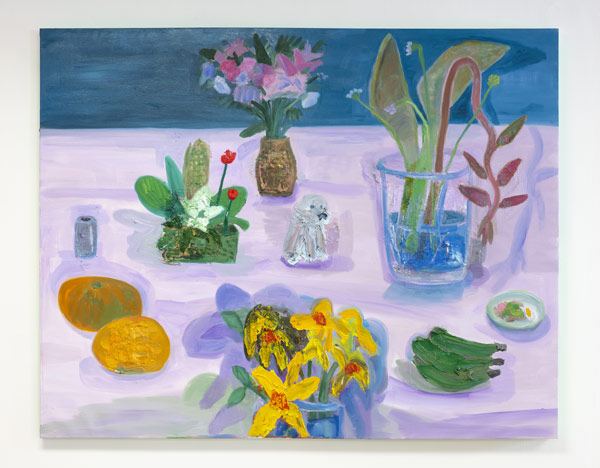
3
Los arreglos de Francisco con chilaquiles y plátanos verdes, 2023
Óleo sobre tela
150 x 190 x 7 cm

4
The Artist as Botero Poodle 1, 2023
Óleo sobre tela
60 x 50 x 3 cm
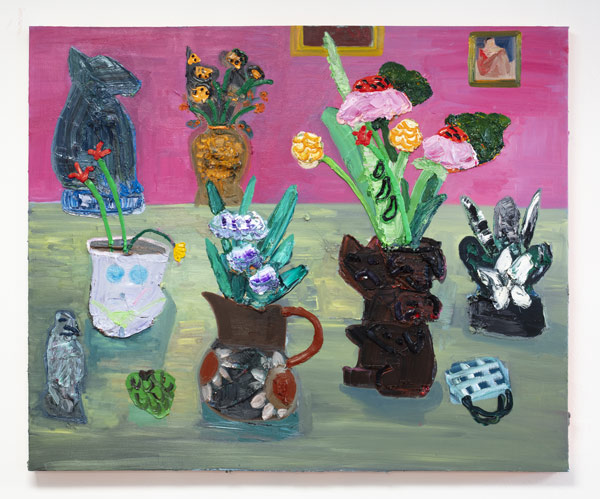
5
Colima Arrangement with wedding present and Joy Laville Vase, 2023
Óleo sobre tela
115.5 x 140.5 x 7 cm

6
The Artist as Volcano 1, 2023
Óleo sobre tela
60 x 70 x 4.5 cm
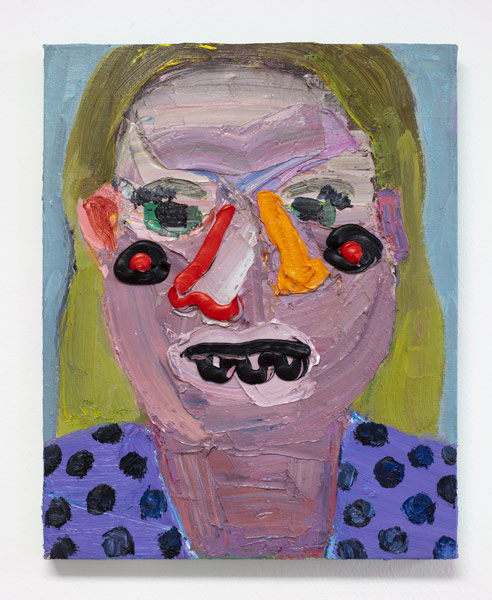
7
The Artist as relic, 2023
Óleo sobre tela
50.5 x 40.5 x 5.5 cm
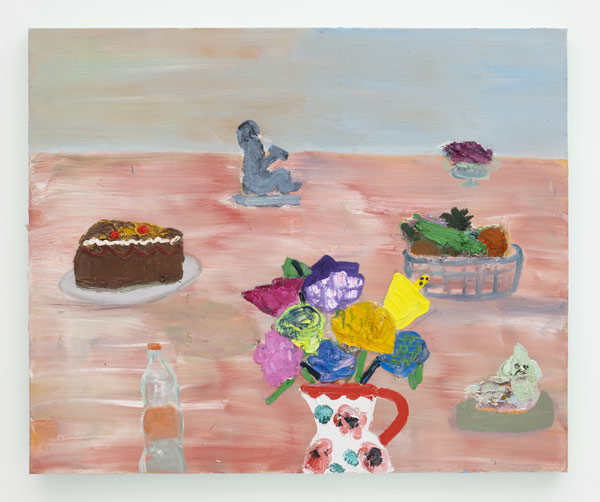
8
Arrangement with Malinalco flowers and chocolate cake, 2023
Óleo sobre tela
115.5 x 142 x 6.5 cm
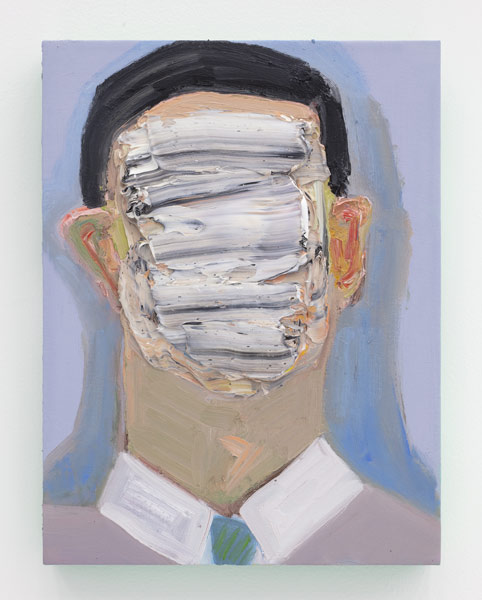
9
The Martyr, 2023
Óleo sobre tela
40 x 30 x 5.5 cm
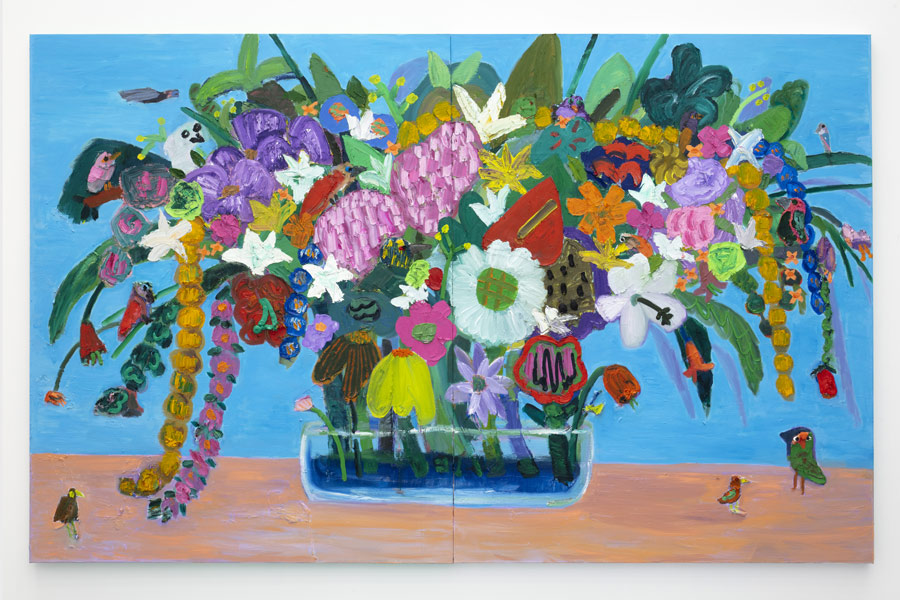
10
Flores de Jamaica, 2023
Óleo sobre tela
226 x 360 x 9 cm
Cada uno: 226 x 180 x 9 cm
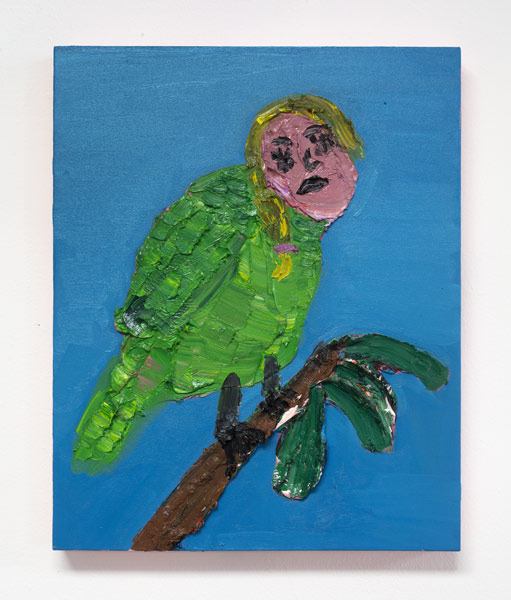
11
The Artist as Green Parrot, 2023
Óleo sobre tela
50 x 40 x 6 cm

12
Night Blooms with Caesar Salad, 2023
Óleo sobre tela
116.5 x 141 x 6 cm

13
The Politician, 2023
Óleo sobre tela
50 x 40 x 6 cm
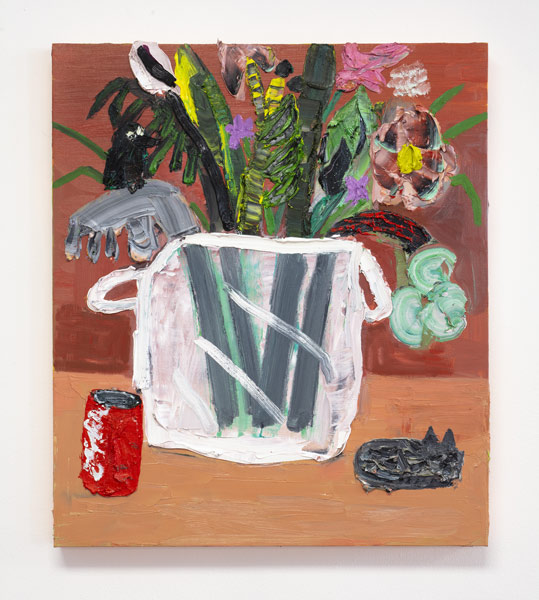
14
Una bolsa de flores con un gatito y una Coca Cola, 2023
Óleo sobre tela
75 x 65.5 x 6 cm
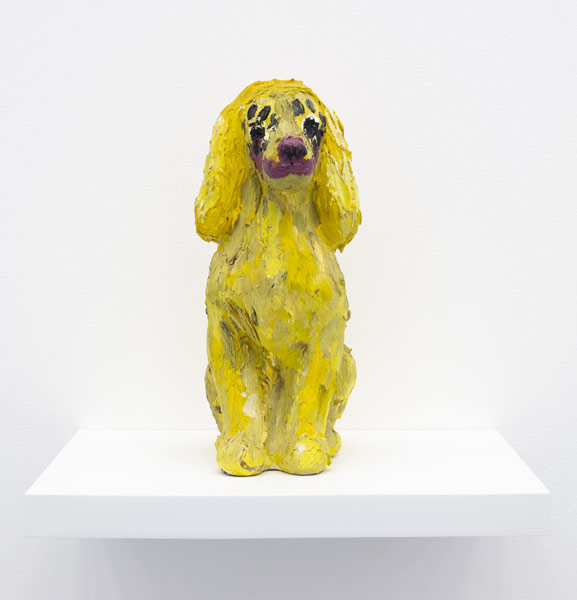
15
Yellow dog, 2023
Cerámica y óleo
28 x 12.5 x 20 cm

16
Day Blooms (Marigolds and Fruit), 2023
Óleo sobre tela
112 x 125.5 x 7.5 cm
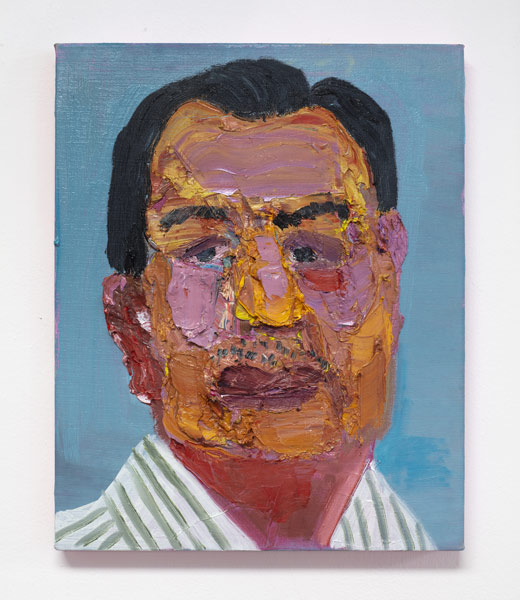
17
Guillermo, 2023
Óleo sobre tela
50.5 x 40.5 x 5 cm
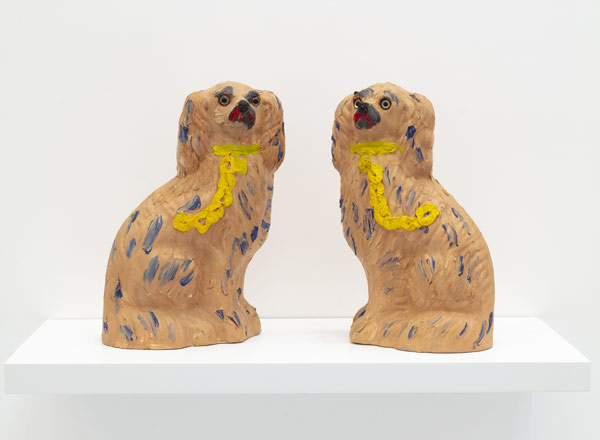
18
Pair 1, 2023
Cerámica y óleo
26.5 x 18 x 11 cm
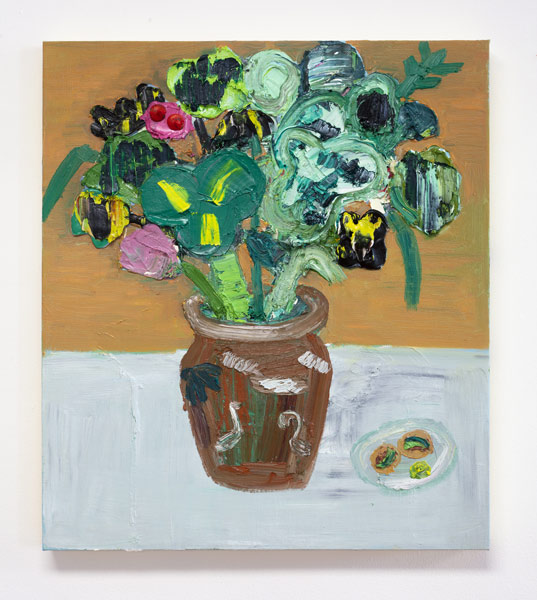
19
Michael's Florero con tostadas de atún, 2023
Óleo sobre tela
75.5 x 65.5 x 6.5 cm
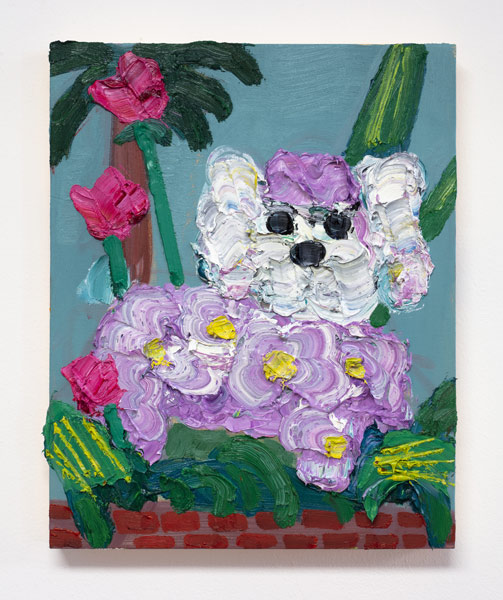
20
Puppy Bouquet 2, 2023
Óleo sobre tela
50.5 x 41 x 6 cm

21
Puppy Bouquet 1, 2023
Óleo sobre tela
50 x 41.5 x 6 cm
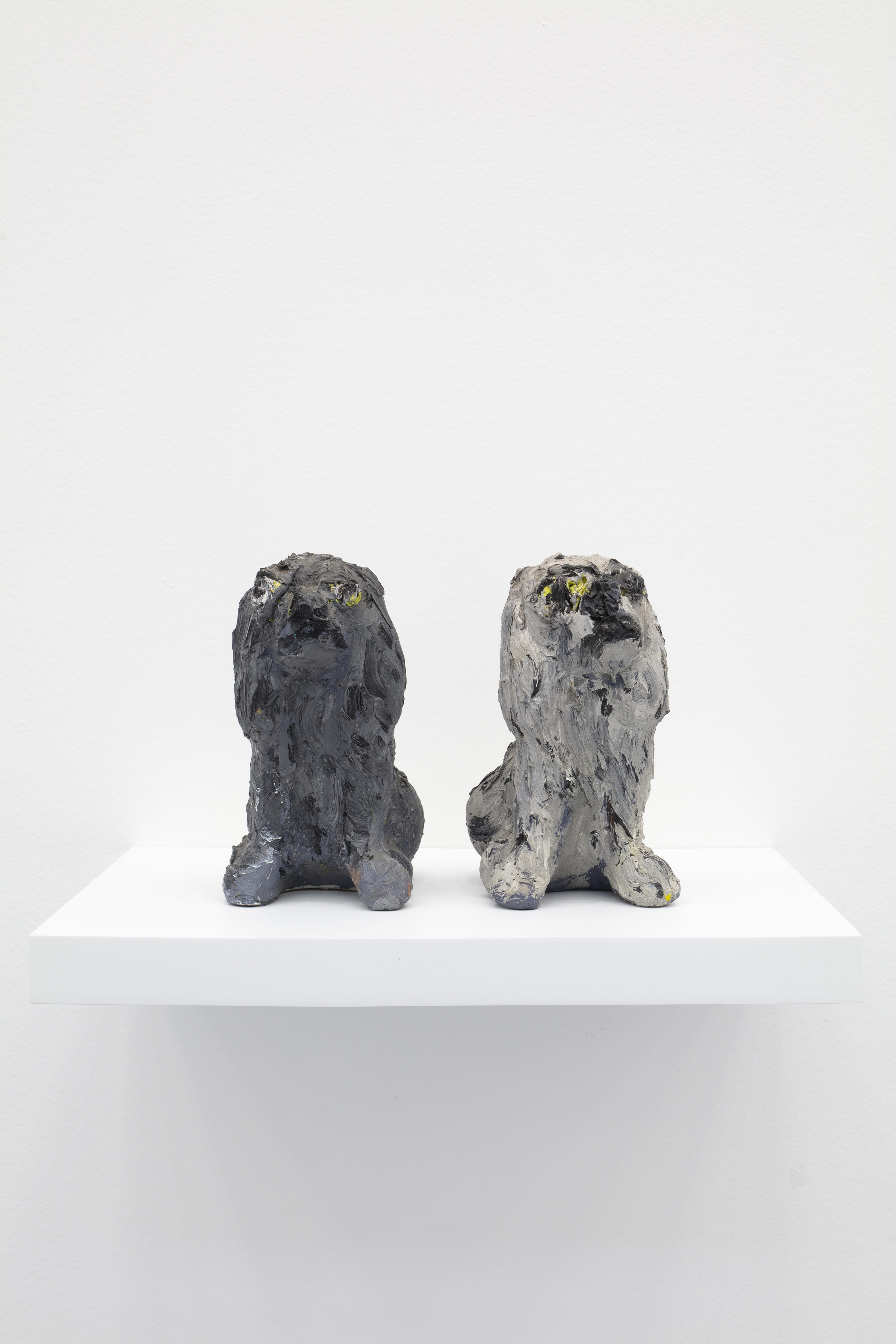
22
Pair 2, 2023
Cerámica y óleo
16.5 x 10.5 x 16.5 cm

1
Flores de Malinalco con un xolo, 2023
Oil on canvas
74.8 x 59.06 x 2.76 in

2
White dog, 2023
Ceramic and oil
9.25 x 4.33 x 7.28 in

3
Los arreglos de Francisco con chilaquiles y plátanos verdes, 2023
Oil on canvas
59.06 x 74.8 x 2.76 in

4
The Artist as Botero Poodle 1, 2023
Oil on canvas
23.62 x 19.69 x 1.18 in

5
Colima Arrangement with wedding present and Joy Laville Vase, 2023
Oil on canvas
45.47 x 55.31 x 2.76 in

6
The Artist as Volcano 1, 2023
Oil on canvas
23.62 x 27.56 x 1.77 in

7
The Artist as relic, 2023
Oil on canvas
19.88 x 15.94 x 2.17 in

8
Arrangement with Malinalco flowers and chocolate cake, 2023
Oil on canvas
45.47 x 55.91 x 2.56 in

9
The Martyr, 2023
Oil on canvas
15.75 x 11.81 x 2.17 in

10
Flores de Jamaica, 2023
Oil on canvas
88.98 x 141.73 x 3.54 in
Each: 88.98 x 70.87 x 3.54 in

11
The Artist as Green Parrot, 2023
Oil on canvas
19.69 x 15.75 x 2.36 in

12
Night Blooms with Caesar Salad, 2023
Oil on canvas
45.87 x 55.51 x 2.36 in

13
The Politician, 2023
Oil on canvas
19.69 x 15.75 x 2.36 in

14
Una bolsa de flores con un gatito y una Coca Cola, 2023
Oil on canvas
29.53 x 25.79 x 2.36 in

15
Yellow dog, 2023
Ceramic and oil
11.02 x 4.92 x 7.87 in

16
Day Blooms (Marigolds and Fruit), 2023
Oil on canvas
44.09 x 49.41 x 2.95 in

17
Guillermo, 2023
Oil on canvas
19.88 x 15.94 x 1.97 in

18
Pair 1, 2023
Ceramic and oil
10.43 x 7.09 x 4.33 in

19
Michael's Florero con tostadas de atún, 2023
Oil on canvas
29.72 x 25.79 x 2.56 in

20
Puppy Bouquet 2, 2023
Oil on canvas
19.88 x 16.14 x 2.36 in

21
Puppy Bouquet 1, 2023
Oil on canvas
19.69 x 16.34 x 2.36 in

22
Pair 2, 2023
Ceramic and oil
6.5 x 4.13 x 6.5 in

